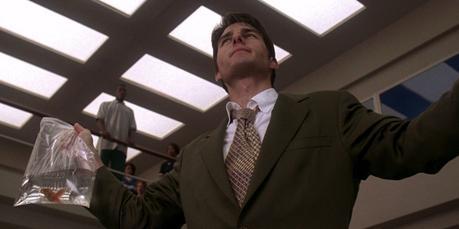
It was hard to escape Jerry Maguire in 1997.
Correction: It was hard to escape people, either in real life or on TV, quoting Jerry Maguire lines at you in '97. So, so many "show me the money!" jokes. Ditto for "you had me at hello" and "the human head weighs eight pounds."
Beyond being eminently quotable, Jerry Maguire is a stone cold classic of the romantic comedy genre, examining what happens to a man who develops a conscience at the worst possible moment in his career and then welcomes love into his life from all sorts of unexpected places. It launched Renee Zellweger's career, netted Tom Cruise his second Oscar nomination (the first being Born on the Fourth of July), made us love Cuba Gooding, Jr. enough to (almost) put up with Snow Dogs and Boat Trip and still easily stands as the most financially successful film of director-writer Cameron Crowe's career. Plus, if you were alive in the late 90s and didn't own this movie on VHS, um, are you sure you really alive? Because damn near everyone seemed to have a VHS copy of Jerry Maguire.
That was 20 years ago, though, which means Jerry Maguire is celebrating a big anniversary right now which means brand new swag (like the 20 th Anniversary Edition Blu-Ray) and interviews to commemorate the occasion which means loads of new insight into the making of a film. Some of the insight is old (e.g., Jay Mohr originally auditioned to play Cushman, not Bog Sugar, the FedEx guy is Jerry Cantrell from Alice in Chains), some of is genuinely new. Either way, here are 8 things I just learned about Jerry Maguire, culled from Cameron Crowe's recent Deadline i nterview.
1. It Was Inspired By a Photograph of an Agent and Football Player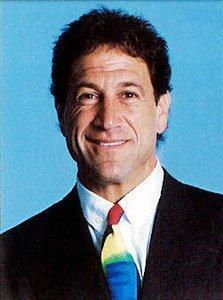
Prior to Jerry Maguire, Cameron Crowe was the boyish young man who'd written for Rolling Stone, gone undercover at a high school to research his Fast Times at Ridgemont High script and pivoted toward writing and directing rom-coms Say Anything and Singles. How does that guy end up making a movie about the world of sports agents?
Crowe didn't know anything about that world, but his interest was piqued when:
[Say Anything/ producer] James L. Brooks handed me this photo from New York Magazine of a sports agent, Gary Wichard [pictured above], and the Boz, Brian Bosworth, who was then a hot property in the NFL. It was just a fun picture of these two guys; one clearly the business, and the other, the brawn. He said, look at this relationship between these guys. What do you think about that kind of a story in this world?
After seeing the picture, Crowe slipped into journalist mode, trailing multiple sports agents to get an inside look at their jobs while also talking to various Hollywood talent agents to find the common grounds between those who represent actors and those who represent athletes. Plus, Crowe had multiple lengthy conversations with Brooks and producer Richard Sakai to hammer out a plot for a movie set in the sports world, vomiting out a 140-page draft which they subsequently fine-tuned by settling on a story structure whereby Jerry loses everything at the start of the movie as opposed to the middle or even later.
2. The real inspiration for Jerry Maguire wasn't really any of the opportunist sports agents who later claimed to be the basis for the character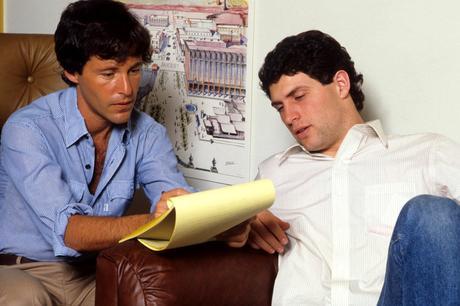
To remember the Jerry Maguire pop culture phenomenon of 1997 is to remember the endless quoting, sure, but also the various profile pieces in magazines and papers claiming to have found the sports agent who directly inspired Jerry Maguire. Turns out, total bullshit. Well, not total exactly, but still far from the truth. As Crowe explained:
We built Jerry from our combined experiences, and then I made it a personal story, masquerading as a mainstream movie. Jerry came from a lot of different fictional places, but we got elements and spice from guys like Leigh Steinberg [pictured above sometime in the 1980s with Steve Young]. He helped me a lot, and opened a lot of doors. Another guy was his somewhat nemesis, Drew Rosenhaus. He was kind of like a Bob Sugar, but the whole idea of putting a focus on personal attention to your clients, that came from conversations with Jim [Brooks].
For example: We talked about what would be the most embarrassing thing that could happen to a shark in the middle of the night, drilled on coffee and bad pizza, and finding a conscience he didn't know he had? What would he say that would really get him in trouble? And that's where we came up with the more personal attention thing. Fewer clients. Less money. Some of the sports agents that I pitched that idea to looked at me like, are you crazy? We would never say anything like that. That's when I knew we were on the right track.
Jerry's mission statement takedown of his own industry was likely less inspired by the actions of any real life sports agent and more by the multiple famous examples of Hollywood executives firing off similar conscience-stricken memos about the dire state of the film industry only to see those memos mocked and passed all around town.
3. Tom Hanks was attached to star during the scripting stage, but Crowe always wanted Tom Cruise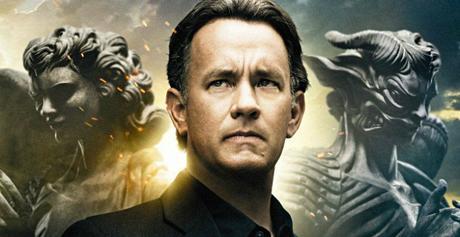
Tom Hanks had a prior working relationship with James Brooks thanks to Big, and the two had been looking to work on something together again. For a while, that something almost became Jerry Maguire, even though Crowe secretly wanted Tom Cruise for the role. Hanks eventually passed in favor of making That Thing You Do!.
Cruise had free some time in his schedule in-between Mission Impossible and Eyes Wide Shut, and he loved the Jerry Maguire script, so much so that he actually volunteered to audition as opposed to simply wanting to be handed the part. The audition obviously went perfectly, particularly once they put Cruise in a suit and realized how much it instantly made him look like a ruthless, shark-like agent.
4. It was Tom Cruise's idea to show Jerry on the sideline during the climactic football game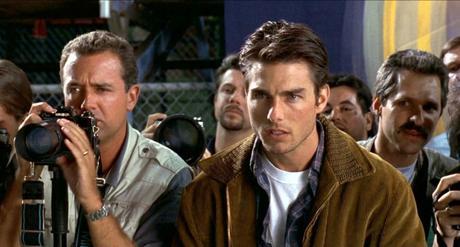
Cruise and Crowe had briefly met at a Fast Times at Ridgemont High after-party, and exchanged "let's work on something together some day" pleasantries after the release of Say Anything. In the time since they'd last spoken, Cruise had become one of the biggest film stars in the world. As such, there were those warning Crowe that Cruise might come in and change everything, as befits the whims of a mega-famous film star. Cruise did indeed request some small changes here and there, but always for the better. For example:
When Cuba Gooding does his end zone dance after getting up from the near concussion on the playing field, Tom said, 'where is Jerry Maguire? I just want to be invested in that moment so that I can build on it towards the end of the movie.' His concern was basic; geographically, how do you get my character in that sequence, because I'm not sure it was spelled out in the script. Of course he was right, and I built it in for Jerry to be on the sidelines.
And here's where insight from one of the actual agents Crowe trailed came in handy:
5. Cameron Crowe didn't get Billy Wilder to act in the film like he wanted, but he at least got a book out of itThis is the thing I got from Leigh Steinberg. When your guy goes down, your first instinct is to get to him, but you can't. Jerry Maguire has a moment where he can't get to his guy until later, in the hallway, and so that increased that later scene later where he does get to Cuba, when all the press is around, and Glenn Frey has his moment (as the football team owner). It became, how to craft Cuba's dance, for both of them. It was smart because I would've been in the editing room going, wait, where's Jerry Maguire?
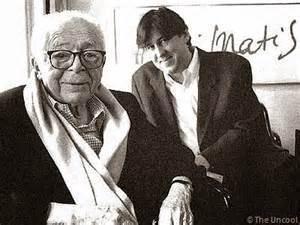
Jerry's mentor Dicky Fox pops up in talking head segments throughout the film to offer his pearls of wisdom, often in contrast to what Jerry's going through at that very moment. The actor giving Dicky his signature pep and optimism was Jared Jussim, who was actually not an actor at all; he was the head of business affairs at the studio (Tri-Star) producing the movie.
Perhaps Crowe just wanted to stick with his gut since his original instinct was cast a non-actor in the role anyway. The first person he went to just happened to turn him down. That person also just happened to be Billy Wilder, the legendary Hollywood director whose film The Apartment was a direct inspiration on Crowe's Jerry Maguire script.
Wilder agreed to play Dicky after meeting Crowe (and mistaking him for a delivery boy), but then no-showed on his first day of filming. Cruise, who had been so excited to get to watch Wilder work, launched a full-scale charm offensive to change Wilder's mind, heading to the legend's office along with Crowe. However, Wilder seemed more interested in casting Cruise in a movie of his own than listening to their pitch about Jerry Maguire. In fact, he didn't even seem to remember having ever met Crowe in the first place. Despite Cruise's insistence, Wilder passed, stumped them by asking, "Why would we feel sympathy for such a character as this sports agent?"
So, Crowe didn't get Wilder to be in the film, but he did get a book out of the ordeal, becoming friendly enough with the Hollywood icon to get the okay to write the 1999 book Conversations with Wilder.
6. Renee Zellweger's sick dog almost cost her the role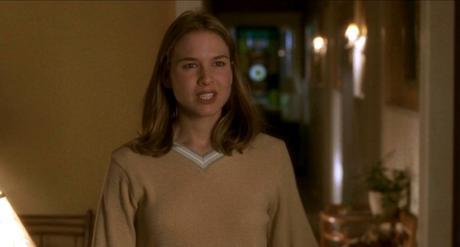
Mira Sorvino, Gwyneth Paltrow and Connie Britton all read for Dorothy, Jerry's partner-in-crime turned wife. Britton even screen-tested. However, the search might have ended sooner had Zellweger's first audition not gone so poorly. As Crow explained:
Gail Levin, who Larry Mark introduced me to, is a casting director. Halfway through this process, she said, there's this girl from Texas that I want you to meet. Her name is Renee Zellweger. She hasn't done much, but she's got... something. She may not be right for this, but you're going to want to work with her. Renee came in and was wonderful. We brought her back in immediately, so Jim could see her too. She was sad that day; I think her dog was sick. It was a good reading, but I remember she left the room, and somebody took a call, and the subject changed. And we never really talked about Renee. It was good, but it didn't light the fire that I think we thought it might. Renee knew it, too. She was sad, and so we continued our search.
It was only later as they were whittling down the candidates that they brought Renee back, realizing she was perfect for the role once they got her on camera for her screen test with Cruise and saw the magic happen.
7. Jonathan Lipnicki was a last second replacement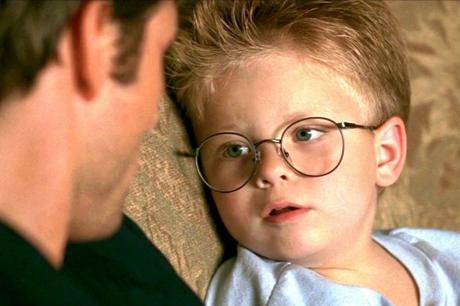
This isn't exactly Michael J. Fox replacing Eric Stoltz halfway through the filming of Back to the Future big, but Jerry Maguire did make a rather significant substitution of its own, forced to re-cast the part of Dorothy's son two or three weeks into filming when the non-actor they'd cast suddenly announced during a scene, "I don't want to do this." Crowe had been adamant about having a non-kid actor in the role, one who wouldn't seem like he'd walked out of a McDonald's commercial. They did that, but that kid quit, receiving secret one-on-one counseling from Cruise in the weeks after that to make sure he understood it was okay to quit and no one was mad at him. Still, they needed a new kid, and in walked Jonathan Lipnicki more or less straight out of a McDonald's commercial.:
8. The young athlete who fake cries while firing Jerry was based on an actress doing the same while passing on a role in one of Crowe's filmsOver the weekend. Gail Levin and Larry Mark went to tireless work, saw a bunch of kids and had this eureka moment. They said they'd found this guy. We were in Arizona and he was going to come and have a little audition.
We bring this kid into Tom's trailer for an audition, and he is exactly what you see in the movie. He's got the hair, the glasses. He is completely thrilled to be acting with Tom Cruise. He says to Tom, 'I've been a fan of yours, my entire life.' He's six. He kills every scene, and as he is leaving the trailer, gives Tom a Maverick Top Gun thumbs up. We look at each other, like we've just seen Elvis in '56. I said, Gail, what has this kid done before? She says, 'only one thing. A McDonald's commercial.' I say, fine, he's in!
As Crowe said, "I made [ Jerry Maguire] a personal story, masquerading as a mainstream movie." Case in point:
That scene with the young athlete who is crying as she fires Jerry, and then takes another call but still has him on the line [as seen at the 4:00 minute mark of the above video]? That came in a call I had with an actress who was disconnecting herself from a part that she had taken in one of our movies. So that was from my own life. She called up, weeping, and then another call came in, and she was like, [cheerful] 'hello?' And I said, it's still me. She's like, 'oh, I feel so bad.' I just remembered being alone late at night in the office, feeling rejected by this actress we really wanted, and it found a home in Jerry Maguire.
I'll close out with this special video The NFL Network made to celebrate Jerry Maguire 's 20th.
Here's a link to their similar video for Cuba Gooding, Jr.'s character.

